Sean McBride's Blog, page 14
March 25, 2021
Blind Read Through: H.P. Lovecraft; The Shadow out of Time, Pt. 1
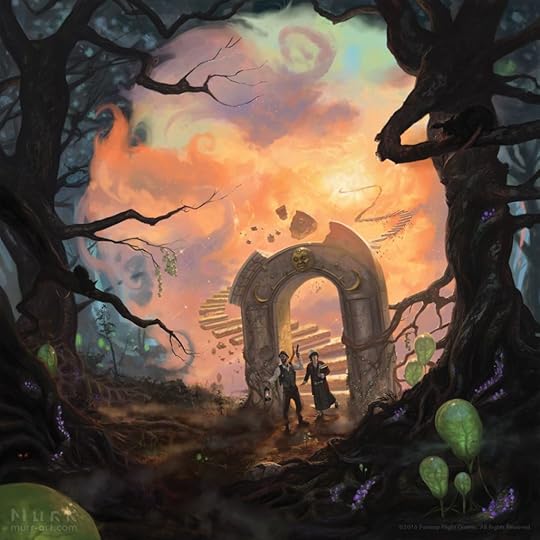
“The essence was always the same – a person of keen thoughtfulness seized with a strange secondary life and leading for a greater or lesser period an utterly alien existence typified at first by vocal and bodily awkwardness, and later by a wholesale acquisition of scientific, historic, artistic, and anthropological knowledge; an acquisition carried on with feverish zest and with a wholly abnormal absorptive power.“
Welcome back to another blind read! This week we trek down a mind bogglingly complex philosophical maze of “nightmare and terror,” in addition to connecting a large collection of Lovecraft’s tales as we try to peel back the layers of the first half of the journey of “The Shadow out of Time.”
This novelette is absolutely the most dense of anything I’ve read by Lovecraft and believe me, breaking it all down is a little daunting, but as the text says at the beginning of the story, “If the thing did happen, then man must be prepared to accept notions of the cosmos, and of his own place in the seething vortex of time, whose merest mention is paralysing.”
The plot of the story surrounds our narrator (Nathaniel Wingate Peaslee) who is a professor at Miskatonic University and by his own proclamations, insists that he has always been sound of mind. That is until he gained a “queer amnesia” which lasted for five years. During that timeframe he became obsessed with “occultism and abnormal psychology,” of which he had never had an inkling towards. During this “lost time” he traveled to the Himalayas, to the Arctic, to the Arabian deserts, to Australia, and even the “vast limestone cavern systems of western Virginia.“
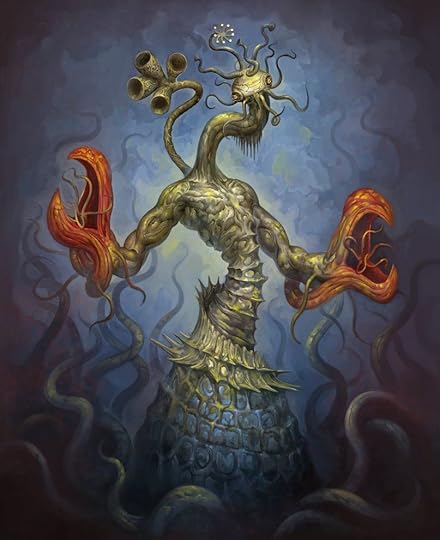 Illustration of the Great Race of Yith
Illustration of the Great Race of YithNathaniel asserts that right before his “lost time” happened he felt “...that someone else was trying to get possession of my thoughts.” which brings into play so many of the previous stories in Lovecraft’s collection. Most recently this makes me think of Asenath from “The Thing on the Doorstep” where she would project her mind into other’s bodies. As we get further into the story, we find there is an Alien species which Lovecraft refers to as the “Great Race” which “With suitable mechanical aid a mind would project itself forward in time, feeling its dim, extrasensory way till it approached the desired period. Then, after preliminary trials, it would seize on the best discoverable representative of the highest of that period’s life-forms; entering the organism’s brain and setting up therein its own vibrations while the displaced mind would strike back to the period of the displacer, remaining in the latter’s body till a reverse process was set up.”
This passage echoes the concepts in the story “The Whisperer in Darkness” as maybe a beginning of the transposition process. Remember in that story that they would extract the brain from the body so that the brain could travel to all reaches of the galaxy to gain new knowledge? Their bodies would be cast aside and their brains would be entered into metal tubes which would be sent with the alien race to space to gather knowledge (if you can believe them).
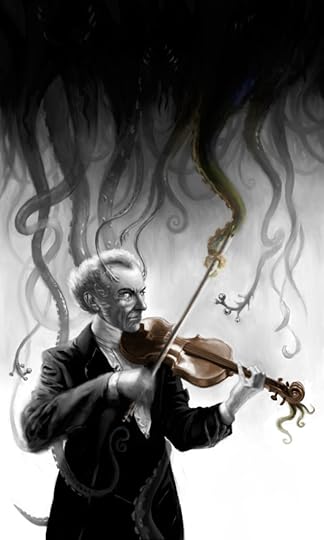 Erich Zann communicating with the Great Race
Erich Zann communicating with the Great RaceWe get even deeper into the mythos as we understand that, “If the mind came from a body whose language the Great Race could not physically reproduce, clever machines would be made, on which the alien speech could be played as on a musical instrument.” Which stands to reason that “The Music Erich Zann” was playing was actually communication to this Great Race and the horror which came from the sight of them: “The Great Race’s members were immense rugose cones ten feet high, and with head and other organs attached to foot-thick, distensible limbs spreading from the apexes.”
So it’s natural to draw the conclusion that it’s this Great Race which has been searching out the history of the universe and transpose themselves into various cultures on planets. They were the influence for Asenath gaining her access to these powers, which also ties them to Dagon and the “Shadow over Innsmouth,” they are an influence on Kingsport with the “Terrible Old Man” and his metal tubes, they influence Arkham as they collect people mechanically and put their brains in tubes. While they enter their subjects bodies they search out as much cosmic knowledge as they can gather from that world, and when they’re done they put the consciousness back into their host’s body. To the host it feels like they are dreaming. We have absolutely heard that before. This story seems to be confirming my suspicion as to what the dreamlands actually are, because right at the beginning of the fourth section Nathaniel tells us, “I continued…to keep a careful record of the outré dreams which crowded upon me so thickly and vividly. Such a record, I argued, was of genuine value as a psychological document. The glimpses still seemed damnably like memories…”
In the Randolph Carter tales (The Silver Key, Through the Gates of the Silver Key, The Dream-Quest of Unknown Kadath, The Statement of Randolph Carter, The Unnamable), our protagonist is called a dreamer. With the help of the Necronomicon, he “dreams” and travels around the universe, interacting with various species. He then uses the Silver Key to go beyond consciousness. In fact in “Through the Gates of the Silver Key” he even becomes one of these creatures.
The layer that’s added with this story is that even though these travels are thought of as dreaming, the real nature of what’s going on here is that these people are traversing time not consciousness. To solidify this concept there’s even a paragraph right in the middle of the fourth chapter:
There was a mind from the planet we know as Venus, which would live incalculable epochs to come, and one from an outer moon of Jupiter six million years in the past. Of earthly minds there were some from the winged, star-headed, half vegetable race of palaeogean Antarctica; one from the reptile people of the fabled Valusia; three from the furry pre-human Hyperborean worshippers of Tsathoggua; one from the wholly abominable Tcho-Tchos; two from the arachnid denizens of earth’s last age; five from the hardly coleopterous species immediately following mankind, to which the Great Race was some day to transfer it’s keenest minds en masse in the face of horrible peril; and several from different branches of humanity.
He goes on to talk of the various historical figures of both Lovecraftian mythos and human history, inexorably trying them together. It is here (it’s discussed in The Dream Quest-of Unknown Kadath as well) in which Lovecraft tells us in no uncertain terms that Time is not a concept of motion or reality, but that Time itself is an alternative universe, which is why people can actually traverse to and from. It is, in and of itself, a dimension, so to understand time travel we have to understand that it’s a linear thing. You go through a gate into another dimension. A dimension of time. This bypasses the problem of physics because it’s a separate dimension of which the Great Race have perfected (alongside some of the Elder Gods) how to traverse it. The same way that Carter was able to get there through the gate using the silver key, and Wilmarth viewed (albeit in a much more crude fashion) in “The Whisperer in Darkness.”
This story is about discovering something from a different dimension, not a different time period, so when we look at the title, we should see it as “A Shadow from Another Dimension,” though, of course, that isn’t nearly as catchy.

SO we know that the knowledge and witchcraft of transposition came from this Great Race and much of what’s happening in Lovecraft’s devised world centers around these beings. In fact when this story opens we are immediately greeted with the knowledge of Prof. Peaslee finding “fragments of unknown, primordial masonry” in “Western Australia.” Similarly, just off the Western Coast of Australia, in the story “The Call of Cthulhu” we find a “cyclopean city” made with strange, impossible angles with unknown materials (primordial masonry?). We know of this city as R’lyeh, the lost city of the god Cthulhu. Could Peaslee have also found evidence of this lost city?
Find out next week as we conclude “The Shadow out of Time!”
March 18, 2021
Blind Read Through: H.P. Lovecraft; The Mystery of the Graveyard, The Mysterious Ship

“In the spring of 1847, the little village of Ruralville was thrown into a state of excitement by the landing of a strange Brig is the harbour. It carried no flag, and no name was painted on its side, and everything about it was such as would excite suspicion. It was from Tripoli, Africa, and the captain was named Manuel Ruello. The Excitement increased, however; when John Griggs, (The magnate of the village) suddenly disappeared from his home. This was the night of October 4th – On October 5th the Brig left.“
Welcome to another Blind Read! This week we work to find the threads which link the Mystery of the Graveyard and The Mysterious Ship to Lovecraft’s larger works, all the while uncovering the enigma of his mind and…potentially…how the mythos came into being. Both of these stories have their beginnings firmly in the dime and nickel novels of the time, pulling from their pulpy plots and over the top protagonists.
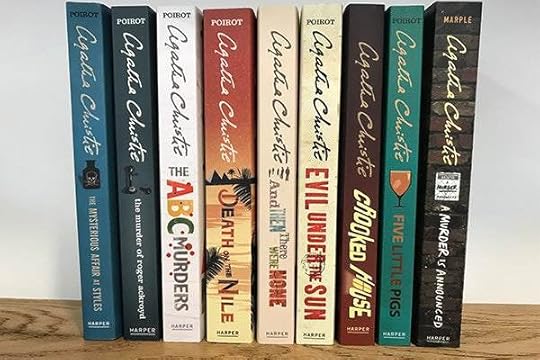 A few of the most popular Agatha Christie Poirot novels
A few of the most popular Agatha Christie Poirot novels“The Mystery of the Graveyard” also goes by the alternate title “A Dead Man’s Revenge” and has remarkable plot twists for the length of the story. Agatha Christie could have had a run for her money if Lovecraft made the turn towards mystery instead of the darker pivot towards horror. He even has a hero detective protagonist to rival Hercule Poirot in King John.
The story begins with the funeral of Joseph Burns. Burns gave some very strange and specific requirements during his funeral. He asked the rector, Mr. Dobson, “Before you put my body in the the tomb, drop this ball onto the floor, at a spot marked ‘A.‘” Dobson goes down to the tomb and does so, but never returns. The mystery follows. The second chapter begins as Dobson’s daughter gets a letter from a mysterious Mr. Bell insisting he knows where her father is and extends a demand of a ransom to get him back. Flustered, she goes to the police and asks for King John who is “a famous western detective.”
The story runs around and around as King John strives to find Bell and figure out the mystery of where the rector went until, finally, he finds that the “A” in the tomb is a trap door that activates with pressure. Dobson fell into a sub-tomb and was hidden away there until he finally escaped. After the trial it was found that all along it was a revenge plot against the rector because Joseph Burns and his brother Francis Burns had a vendetta and hired Mr. Bell to trap and hold Dobson.
The story is told in twelve very short chapters…so short that in fact they are each only a few sentences long and every chapter has a title letting the reader know what to expect. This also strikes me as Lovecraft’s way of structuring his thoughts. When we look forward to other works like “The Case of Charles Dexter Ward” as a long example and my more recently reviewed “The Thing on the Doorstep” as a shorter example, Lovecraft has a certain structure in his writing in which is easier to elucidate with these stories. In both “The Case of Charles Dexter Ward” and “The Thing on the Doorstep” Lovecraft breaks his writing up into chapters, but instead of having a single narrative flow, those chapters are almost single distinct stories in and of themselves. For example in both stories the first chapter is about the protagonist of the story (other than the narrator of course). It gives the reader the background and the perspective of the (supposed) “hero” of the story. The second chapter of these stories gives background to the antagonist (Curwen in “Ward” and Asenath in “Doorstep”), then each subsequent chapter has an event which drives the narrative forward. “The Mystery of the Grave-Yard” is the same type of structure, though Lovecraft breaks this down even further, presumably so he can keep the narration on track…a common tool for very young, or beginning writers. Notice how he begins the plotting the same way (Chapter 1 is about the main focal point of the story, Dobson, and chapter two introduces Bell, the main antagonist), and then has each chapter surrounds an individual event. In his later years he does a better job at painting a bigger, more lush picture by expounding on detail and experience. Tone and atmosphere are what Lovecraft is missing in his Juvenilia, but it’s what he perfects later in life and makes him the legend of horror and supernatural that he is. This point is proven even more when we move onto the next story, “The Mysterious Ship.”
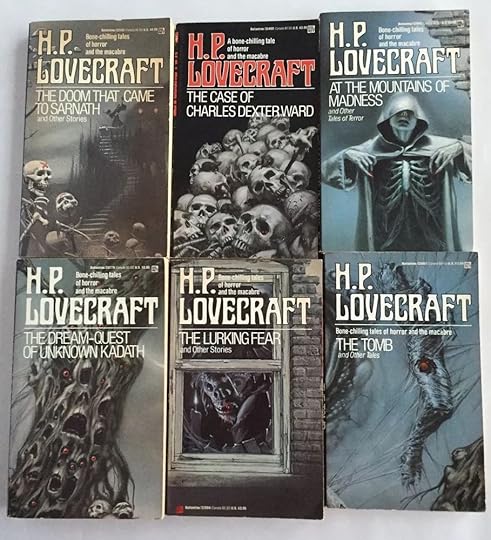 The Del Rey editions illustrated by Michael Whelan
The Del Rey editions illustrated by Michael WhelanThis second short is told two different times in the collection I have (I’ve actually gone through a number of different collections, starting off with the Del Rey books. Where the artwork in those books are excellent, the collections themselves aren’t that great. Language was changed and in the process, meaning seems to have changed. I’m currently working of the most recent Barnes and Noble edition which seems to be far superior), the first is an earlier shorter edition and the second is a more fleshed out atmospheric piece, where each chapter is just a few sentences longer and gives a clearer understanding and better atmosphere than the shorter one before it. These two vignettes give a better glimpse of the growth of the writer than nearly anything else I’ve seen. Lovecraft is devoid of the pomposity of literature of someone like Pynchon because Lovecraft’s first love was adventure. He wanted to tell stories that were weird and fun and wild, which led to his unique “serious, but pulpy” tales. He chose his archaic and complex writing style to compliment the wild stories he wanted to tell, not the other way around. It may seem like a small distinction, but it’s an important one.
 The BN edition with an introduction by S.T. Joshi
The BN edition with an introduction by S.T. JoshiBack to the adventure! The second story follows the titular ship which you can see in a little bit of detail in the opening quote to this essay (which is in fact the opening chapter of the longer version). It’s about a ship which journeys around and kidnaps people. The Captain and crew are eventually caught and the purloined victims are returned, bringing the story to a nice ending all tied up in a bow. The tale doesn’t have much in the way of satisfaction, but it does show Lovecraft’s love for adventure.
 excellent early stories by Thomas Pynchon
excellent early stories by Thomas PynchonBetween the two of these stories you can see the natural divergence of the path in which Lovecraft took. We have the standard horror or cosmic horror element with the Mystery of the Grave-Yard, in that atmosphere and the darker places he normalizes as just standard backdrops for the story…complete with sneaky plotters and nefarious acts. Then we have the adventurous bend we take with The Mysterious Ship, which feels like the beginnings of the dreams lands and such stories as “The Dream-Quest of Unknown Kadath.” These tales aren’t so much focused on the horror elements as they are on the adventurous journeys the protagonists (well really just Randolph Carter) take.
I kept these Juvenilia for the end because I wanted to have something to call back on while discussing them, and I can’t say how glad I am that I did. To be able to see the growth is tremendous and its always fun to see how a writer that I’ve become this involved in began.
Next week we dive into the last story Lovecraft wrote on his own. It means this series is rapidly coming to an end, but we still have a bunch of the stories which August Derleth wrote with Lovecraft’s notes and I plan on ending this series with Lovecraft’s essay on Horror.
Join me next week as we view the “Shadow out of Time.”
March 11, 2021
Blind Read Through: H.P. Lovecraft; The Thing on the Doorstep

“What he did do was to become an almost fanatical devotee of subterranean magical lore, for which Miskatonic’s library was and is famous. Always a dweller on the surface of phantasy and strangeness, he now delved deep into the actual runes and riddles left by a fabulous past for the guidance or puzzlement of posterity. He read things like the frightful Book of Eibon, the Unaussprechlichen Kulten of von Junzt, and the forbidden Necronomicon of the mad Abdul Ahlhazred, though he did not tell his parents he had seen them.”
Welcome back to another Blind Read! This week we’re sinking into a story which brings together much of Lovecraft and his themes, while simplifying the language to tell a straightforward horror tale…all while (potentially) creating yet another horror trope!
Lovecraft begins the story, like he does in so many of his stories, by immediately telling us how it will end: “It is true that I have sent six bullets through the head of my best friend, and yet I hope to shew by this statement that I am not his murderer.”
This leaves us as readers to ruminate on what the story is to be as we move forward. At the moment in time Lovecraft was writing this could have potentially been a tactic to heighten suspense, but to the modern reader who has seen so many of these themes over and again as authors re-use tropes, it falls a little flat. To start this way, we as readers know exactly how this story ends and unfortunately there aren’t any twists to surprise us.
Stephen King once wrote that (I’m paraphrasing) he goes for the creep out and if that doesn’t work he goes for the jump scare, and if that still doesn’t work he goes for the gross out. Lovecraft recognized that he wasn’t going to get the creep out, and he’s never been much for the surprise scare, so he went straight for the gross out.
Don’t let that detract from the story however because what Lovecraft does along the way is bring the history of his Lovecraft country all together and develop a disturbing little story.
The tale is mainly about Edward Pickman Derby. Sound familiar? That’s because it is. Lovecraft does a strange things with names here. Pickman is the surname of the infamous artists Richard Upton Pickman from “Pickman’s Model.” A man who housed monsters to draw and create fantastical art. In addition to this, the narrator of this story (Daniel Upton) has a child and names him Edward Derby Upton. I thought and thought about this connection. Are these characters connected to Richard Upton Pickman? The more I think about it the less I think that’s the case. I think it’s Lovecraft’s way to show how connected everything in his world is. To show how everything seems to stem from Salem, Mass (many of these characters have family trees which date back to there), or to mysterious travelers from mysterious ships. There is a connectedness in the collective consciousness of the people of Lovecraft Country, which gives credence and horror to the small town trope (all those locals staring at you as you drive through).
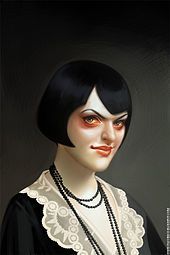 Popular concept art for Asenath
Popular concept art for AsenathRuminating on this we move onto the second chapter and we learn about Edward’s wife Asenath Waite, “She was a dark, smallish, and very good-looking except for over-protuberant eyes; but something in her expression alienated extremely sensitive people.” We find that she grew up in Innsmouth, the notorious village from “The Shadow over Innsmouth” which worshipped Dagon and bred with the fish-people. We find that she went to Kingsport high school (the slightly less nefarious town from such tales as “The Terrible Old Man” and “The Strange High House in the Mist.”) and had a “odd reputation” before moving on to Miskatonic University where she studied “mediaeval metaphysics” and had some “well-attested cases of her influence over other persons.” Students considered her a hypnotist because, “By gazing peculiarly at a fellow-student she would often give the latter a distinct feeling of exchanged personality – as if the subject were placed momentarily in the magician’s body and able to stare half across the room at her real body, whose eyes blazed and protruded with an alien expression.”
Edward meets young Asenath (who at twenty-three already has crow’s feet at her eyes) and they begin to date. Soon after Edward brings her to meet Daniel who had reservations but, “…I saw at once that his interest was by no means one sided. She eyed him continually with an almost predatory air, and I perceived that their intimacy was beyond untangling.” A month later the couple was married.
They, as a couple, delved into the occult. Asenath had a history of it from her father, Ephraim Waite, who studied the occult before his death in Innsmouth. Everything seemed good for the first year of their marriage, but then “people began talking about the change in Edward Derby.”
“People said he looked too much like his wife, or like old Ephraim Waite himself...” and then after three years of marriage to Asenath, “Edward began to hint openly to me of a certain fear and dissatisfaction.” and “...would talk darkly about the need of ‘saving his identity.‘”
 Is this book inspired by this story?
Is this book inspired by this story?At this point in the story I knew exactly what was happening and if anyone has seen the Nexflix show “Behind Her Eyes” you’ll know the outcome as well. It’s about transposition, and if we know anything about Lovecraft it’s about a man who is looking for extended life to continue on with his power gathering…I.E. Ephraim.
At the beginning of chapter four Edward speaks with Daniel and spouts his entire fears:
Dan – for God’s sake! The pit of shoggoths! Down the six thousand steps…the abomination of abominations…I never would let her take me, and then I found myself there…Ia! Shub-Niggurath!…The shape rose up from the altar, and there were 500 that howled…The Hooded Thing bleated ‘Kamog! Kamog!’ – that was old Ephraim’s secret name in the coven…I was there, where she promised she wouldn’t take me…A minute before I was locked in the library, and then I was there where she had gone with my body – in the place of utter blasphemy, the unholy pit where black realm begins and the watcher guards the gate…I saw a shoggoth – it changed shape…I can’t stand it…I wont stand it…I’ll kill her if she ever send me there again…I’ll kill that entity…her, him, it…I’ll kill it with my own hands!
And there we come to the horrible realization that Edward is actually married to Ephraim! Eww!
In all actuality he is probably married to some older creature who has since invaded Ephraim’s body, although there is a pretty hilarious moment with Ephraim: “Why did he curse that his daughter wasn’t a son?” Because he knew to transpose his mind it would have to be into his offspring, who would have a stronger hold on the otherworldly magics. Then in turn Asenath’s child would be that much stronger; but to have any of that happen, Ephraim would have to find someone to impregnate him while he was in Asenath’s body. I can imagine the curses coming from a crotchety old straight man!
Knowing Lovecraft, this could and should be the end for Edward, but suddenly he is able to somehow “convince” Asenath to go away and leave him alone. He spends a little time with Daniel, by now just a shell of a man, trying to get his life back together and eventually goes back to his home. He’s there for a while before he has a break down, calling Daniel:
“My brain! My brain! God, Dan – it’s tugging – from beyond – knocking – clawing – that she-devil – even now – Ephraim – Kamog! Kamog! – the pit of the shoggoths – Ia Shub Niggurath! The Goat with a Thousand Young!...”
He goes into the Arkham Sanitarium and Daniel goes to visit him when Daniel has a terrible realization. Edward is no longer Edward. Kamog has somehow come back to take over. Daniel shoots the form of his best friend…six times…hoping to kill the evil wizard which presides inside him.
 The Thing on the Doorstep by Paul Carrick
The Thing on the Doorstep by Paul CarrickThe entire time reading this, I was entertained, but wondered where the title came from…that is until we get to the end of the story. A figure appears on Dan’s doorstep. It smells terrible and it’s diminutive. It’s wearing “one of Edward’s overcoats” with “a slouch hat pulled low” and “a black silk muffler concealed the face.” It makes a watery noise and hands Dan a letter from Edward.
In the epistle we find out Asenath “has been dead three months and a half.” Edward killed her by smashing her head in with a candlestick. Then when he was in the sanitarium she worked on “seizing my body and putting me in that corpse of her buried in the cellar.“
Dan faints, but when he comes to he calls the authorities. “What they finally found inside Edward’s oddly assorted clothes was mostly liquescent horror. There were bones, too – and a crushed-in skull. Some dental work positively identified the skull as Asenath’s.”
The thing on the doorstep was Edward, inside of the rotting corpse of Asenath. What makes it so horrible and so…Lovecraftian…is that Kamog has already lived through at least one murder, which means that he may be hovering somewhere above Arkham just waiting to find the next body to inhabit…
Lovecraft went full force into the gross out, but he tried to leave a little creep out at the end…
Join me next week as try to solve “The Mystery of the Grave-Yard” and understand “The Mysterious Ship!”
March 4, 2021
Blind Read Through: H.P. Lovecraft; The Little Glass Bottle / The Secret Cave

“The Funeral of alice occupied so much time that John quite forgot about the box – but when they did open it they found it to be a solid gold chunk worth about $10,000 enough to pay for any thing but the death of his sister.“
Welcome back to another Blind Read! This week we go even further back in time to discover Lovecraft’s beginnings and tackle concepts of trauma, loss, desire, and adventure in two Juvenilia tales that are anything but polished.
I debated for a while whether I really wanted to cover these after reading them, but in the end I decided to hold my promise. I said I would read as much Lovecraft as I could get my hands on, so I’m holding to my word. The question is, how would I deconstruct these stories? They reminded me of my own work when I was young…and when I mean young I mean ten or eleven (which probably means that Howard was about six when we equate talent). The writing is subpar with grammar errors abounding and the stories themselves are just little ditties which any youth could come up with.
What I eventually found more interesting, however is that instead of taking a look at the story itself, I decided to take apart the themes to get a deeper glimpse into the man and what would eventually make his writing the legend that it became.
 The Robert Louis Stevenson Classic
The Robert Louis Stevenson ClassicThe first story “The Little Glass Bottle” seems to be an effort at humor biting off of “Treasure Island” which was published about ten to fifteen years prior to Lovecraft writing this story. It follows a group of sailors who find the titular bottle floating on the sea. The bottle had a letter inside:
Jan 1 1864 I am John Jones who writes this letter my ship is fast sinking with a treasure on board I am where it is marked * on the enclosed chart…dotted lines represent course we took
Enclosed is a drawing of a dotted line through the Indian Ocean just off of Australia. Captain Jones gets so excited that he decides to go after it: “in 4 weeks the(y) reached the place where directed & the divers went down and came up with an iron bottle…“
Inside of the bottle they find a note:
Dec 3 1880 Dear Searcher excuse me for the practical joke I have played on you but it serves you right to find nothing for your foolish act – However I will defray your expenses to & from the place you found your bottle I think it will be $25.0.00 so that amount you will find in an Iron box I know where you found the bottle because I put this bottle here & the iron box & then found a good place to put the second bottle hoping the enclosed money will defray your expenses some I close – Anonymous
They dive down and get the money and we end with a little meta story telling: “...I hardly think that they will ever go to a mysterious place as directed by a mysterious bottle.”
This absolutely has a childish feeling and a fear of taking things too far. So really not much to it. But lets take a deeper look…
 R’lyeh as envisioned by Francois Baranger
R’lyeh as envisioned by Francois BarangerFrom an early age it’s obvious that Lovecraft is fascinated with the Ocean. There must be a correlation in his mind with something important being there, or somewhere in the area surrounding Australia. This, one of his first stories, leads some intrepid adventurers there to discover a treasure which turns out to be a fraud. Many years later in basically the same area, in a tale named “The Call of Cthulhu” some explorers go in search for answers and come across R’lyeh and the Elder God Himself. This is a similar journey in a similar area. A group of men looking for fortune and power and find out they vastly underestimated what they were looking for.
The difference come with age. In this story the person who sent them on the wild goose chase is contrite, a sentiment I don’t think I’ve seen in Lovecraft. We know Howard becomes jaded as he gets older and that absolutely shows through in his stories, because the characters are just too far gone down the rabbit hole to turn back. Here we see that, for Lovecraft himself, it is not yet too far. He hasn’t yet had the heart ache…he hadn’t yet survived the trauma. He still believed that though there is a darker side to humanity, the inherent goodness can come through. That is noticeably absent in the second tale.
“The Secret Cave” is like a Grimm’s Fairy tale. It’s a simple story about a horrible tragedy. It dives into grief in such a complex way, and in so much more of a profound way beyond any of his other stories, that as a reader it feels as though we are getting a glimpse into mental walls he put up to block out the horrors of his life.
The story begins with two young children, John and Alice, getting left alone in their house as their parents go away, presumably on a date. The two children go into the cellar to play, and Alice accidentally does something to cause a wall to cave in. John goes back upstairs and grabs some candles to light their way as they go exploring behind the collapsed wall.
The story takes a strange turn here and the reader gets the feeling that it’s something that’s in John’s head, a fantasy of an adventure prevalent in young children. Here is the disjointed passage:
“…the(y) walked on farther & pretty soon the plastering left off & they were in a cave Little alice was frightened at first but at her brothers assurance that it was “all right” she allayed her fears, soon they came to a small box which John took up & carried within pretty soon they came on a boat in it were two oars he dragged it with difficulty along with him soon they found the passage came to an abrupt stop he pulled the obstacle away & to his dismay water rushed in in torrents...”
Later something occurs to him “…he can shut off the water...”, which he does, but then finds that his sister had drowned. The last paragraph is the opening quote of this essay.
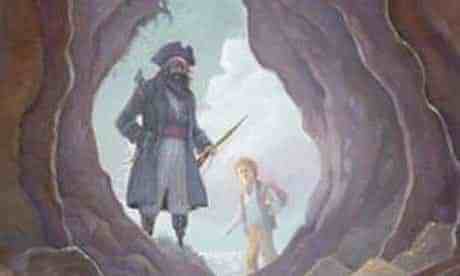
It’s a gruesome little tale, but there is SO much packed into the passage of their “adventure.” It’s here we get the first indication something is off in the story. We go from a normal cellar to a strange, almost other worldly cave, something that fits the adventure theme because it seems like this cave would be right at home on Treasure Island. Why is it mysterious you ask? Because it’s a dry cave…but it has a boat and oars in it as well as a mysterious box that when opened contains a solid gold bar worth $10,000. The cave goes no where, it just dead ends, but John finds an “obstacle” which when removed creates a deluge. Once he saves himself with the edge of the boat the boat is never mentioned again, but suddenly he realizes he can shut off the water.
How could you use a valve to shut off water? Why, you can if there’s a water main!
The whole story is a fabrication. John Lee was going on an adventure in his head, when in reality he was just hanging out in his basement and a wall which held their water heater broke open and flooded the cellar. John was never scared like his little sister, because he knew they were only in the safety of their own basement the whole time.
But still his sister died, which brings me to my next point. Why was John capitalized the whole story and Alice in lower case? Was this some sort of sexism Lovecraft was practicing subconsciously? I really don’t think so.
This story is absolutely part of his early writings. The plotting is truncated and hazy, the grammar is atrocious, the writing is simple, but this story is a clear representation of how Lovecraft dealt with his own grief and how he dealt with the outside world.
The story is told in past tense, but the POV is muddled. It goes from 3rd person omniscient to 3rd person personal pretty fluidly. When the action is taking place, we are inside of John’s head, but when the scene is being described we are looking at the action as a fly on the wall. One gets the feeling that this was an unconscious effort to say that when bad things are happening to us, things become disjointed and too close to really understand what’s happening, it’s only in hindsight when we have a better understanding of what happened. So what does this have to do with the capitalization of Alice?
John goes on an Adventure, and the spoils of that adventure are $10,000, but the cost is his sister’s life. Like the last line says it was a “solid gold chunk worth about $10,000 enough to pay for any thing but the death of his sister.”
Worth any thing. He has come to an early realization that nothing can cover up the grief, and blames himself for causing the death of his sister. There is a feeling to this piece of tremendous sadness and uncontrollable self doubt and self hate. Alice isn’t capitalized in this story because to capitalize her would make her a person. To keep her lower case means she can just be a thing, and maybe, just maybe, that 10K can do something about it.
Join me next week as we take a glimpse at “The Thing on the Doorstep.”
February 25, 2021
Blind Read Through: H.P. Lovecraft; IBID
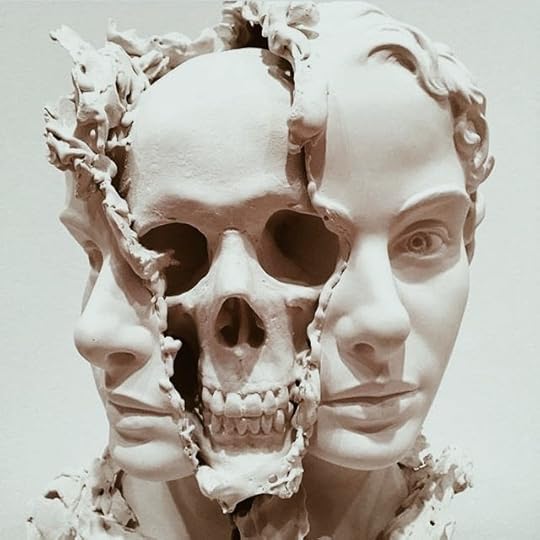
“It was in the house of Dexter, in the northern part of the town near the present intersection of North Main and Olney Streets, on the occasion of Canonchet’s raid of March 30, 1676, during King Phillip’s War; and the astute sachem, recognising it at once as a thing of singular venerableness and dignity, sent it as a symbol of alliance to a faction of the Pequots in Connecticut with whom he was negotiating. On April 4th he was captured by the colonists and soon after executed, but the austere head of Ibid continued on his wanderings.”
Welcome back to a very strange Blind Read! This week we contemplate academia while ruminating on relevance, legacy, and idolatry and wax poetic while following Lovecraft’s lead!
What a odd, curious whimsey this story was. There really isn’t much to it as it’s primarily a brief satire of what Lovecraft deemed academia of the time period… but if we look closely, beyond the gallows humor indicative of the man, and past the analogy he was striving for, we catch some strange influences into his other works. Themes that seeped into popular culture over the years which have not been present in his others works. Theme’s subsumed within a blanket of normalcy. Ok, I’ll stop being coy, let’s get to it!
Like I said, there’s not much to the story (especially the length), but we get the analogy immediatly with the opening sentence:
“The erroneous idea that Ibid is the author of the Lives is so frequently met with, even among those pretending to a degree of culture, that it is worth correcting.”
This is immediately following from an opening quote (“…-as Ibid says in his famous Lives of the Poets.” – From a Student theme.)
We then get a brief glimpse of the history Ibid himself (with some ridiculous speculation on his name which puts together many Ceasar’s and common Roman names together…there may be something to this, but it’s not something I caught: Caius Anicius Magnus Furius Camillus Aemilanus Cornelius Valerius Pompeius Julius Ibidus) before Lovecraft describes how the man’s skull is passed from person to person throughout history. From ancient Rome to Charlemagne, from private citizens to soldiers, from Native Americans to witches. This skull is passed as heirloom, as an art piece, as a magical talisman, and as a curiosity. There are even scenes which recall Hamlet and his famous Yorick scene where he gazes at the skull, nay into the skull, as though there is some deeper meaning or power within it.
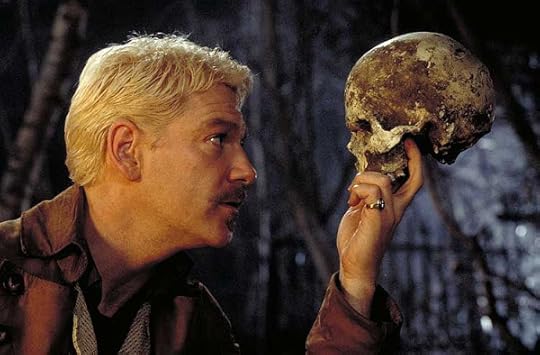 Kenneth Branagh in the best version of Hamlet
Kenneth Branagh in the best version of HamletSo what is the point? Why follow along with a supposed “Learned Man” and then his skull afterward? The quote would seem to indicate that Lovecraft is railing against the stupidity of the uninformed at first. From the matter of a student wrongly using a quote, to Lovecraft ridiculing those who don’t know the truth:
“It should be a matter of general knowledge that Cf. is responsible for this work“
“There is a false report – very commonly reproduced in modern books...”
This seems to be the idea, but then, after we survive a page of brain numbing etymology, we get this sentence: “His full name – long and pompous according to the custom of an age which had lost the trinomial simplicity of classic Roman nomenclature…“
Then we go into a romp of the mans skull through history. Why would the man’s skull, as it outlines in the quote at the beginning of this essay, be “a thing of singular venerableness and dignity” when the only reason it’s available to be handed down is because it was “exhumed and ridiculed by Lombard Duke of Spoleto, who took his skull (after exhuming it) to King Autheris for use as a wassail-bowl.“
 Many cultures used Skulls as bowls
Many cultures used Skulls as bowlsIt’s because Lovecraft is poking fun at the pompous nature of academia in general. These people are so focused on revering something which was created to use as a drinking vessel, but attribute all means of power to it because of it’s age and the misguided idea of what he wrote.
This threw me for a while as it seems as thought Lovecraft is making fun of himself, after all one of his primary themes which pop up again and again is the idea of gathering knowledge and respect for learning. Is this supposed to be another navel gazing romp? Is Lovecraft saying he isn’t taking himself too seriously so we shouldn’t? Or is he saying that maybe he has taken himself too seriously and should stop? I think it goes deeper than that.
When we think about characters like Curwen in “The Case of Charles Dexter Ward” they are the ones pursuing these dark powers. They are the ones pursuing the dark underbelly of nature by seeking out these vessels of the outer gods. It’s a theme that I’ve mentioned many times and it’s a theme which comes up again and again in Lovecraft. Characters who seek out knowledge to understand more about the universe.
There’s only one character whom has been able to do this and not paid a terrible price. That’s Randolph Carter. What makes Carter unique is that he didn’t actually strive for the knowledge, rather it was thrust upon him and he adapted and worked with it to better understand his place. Carter’s wasn’t a path of power, but rather of understanding. I think that’s the crux here. Yes, Lovecraft is railing against the pomposity of academia and learning, which he seems to revel in, but instead he’s pushing back against the idea of false knowledge.
Lovecraft is playing with us before we even start reading. Ibid is actually a writing tool. Ibid is an abbreviation of the Latin “ibidem” which means in the same place. When you see the word ibid in a reading list it is referring you to material in a source just mentioned. For example it could be another chapter of a book that has just been referred to. Even with the title Lovecraft is playing with us, as he’s letting us know that he’s mentioned this concept multiple times. He’s referencing back to his previous works. This whole story is merely a reference to prove his thesis in his current (at the time he wrote this) oeuvre.
Anything can be twisted to fit a narrative. The whole point of much of Lovecraft’s cosmic gods is the idea that we’re insignificant in comparison to the beings actually running the show. If you’re striving for power, your talisman will end up being a mug from some smart dead guy, but if you’re goal is respecting and living with that power, then and only then, will you end up with “The Silver Key.“
Join me next week as we delve into some of Lovecraft’s earliest work with “The Little Glass Bottle!”
Post Script:
One last this before you go. There is one last thing which this story brought to my head (pun totally intended). One big visual within Lovecraft’s legacy is the idea of the head sprout. Whether that’s from fungi breaking through the skull (an Example is from “Fruiting Bodies” by Brian Lumley), creatures breaking through (we’ve actually seen this in “The Haunter in the Dark“), or people gaining such “insight” that they literally have thoughts (creatures) as an extension of their skull (think the tokens in the game Bloodborne).
The mere fact that so many of the historical people and the fictional characters in this story thought they could gain power or knowledge from this skull made this correlation immediate in my brain. This is not much of a story, but although this is supposed to be a “Blind Read” (meaning that I’m reading the story for the first time, without knowledge of it), I read this one twice. I feel as though I’m still missing references and innuendo, but if I can leave you with anything that represents Lovecraft to me, I’ll leave you with this image:
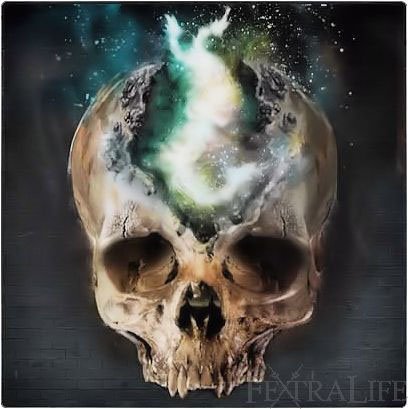 Madman’s Knowledge item from Bloodborne
Madman’s Knowledge item from Bloodborne
February 18, 2021
Blind Read Through: H.P. Lovecraft; The Haunter of the Dark
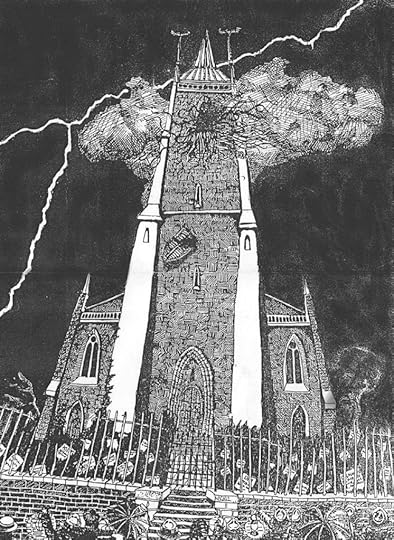
“Plodding through the endless downtown streets and the bleak, decayed squares beyond, he came finally upon the ascending avenue of century worn steps, sagging Doric porches, and blear-paned cupolas which he felt must lead up to the long-known, unreachable world beyond the mists.”
Welcome back to another Blind Read! This week we are tackling the darkness and entreating to hold a candle to the mystery and banish the Haunter of the Dark!
I had to sit and ruminate for a while on this one to decide whether it was genius, or if there wasn’t much going on. I think this is what happens when people read Lovecraft in succession like this for as long as I have. The connections are the same, the locations just change. We absolutely get the influence of the Mi-Go, much like we had in The Whisperer in Darkness, and some direct contact with the Outer Gods. What I’m finding more and more intriguing with these stories is that there is absolutely a theme of the connectedness of madness and genius. This story though, had a new surprising twist which took me a while to pick up on.
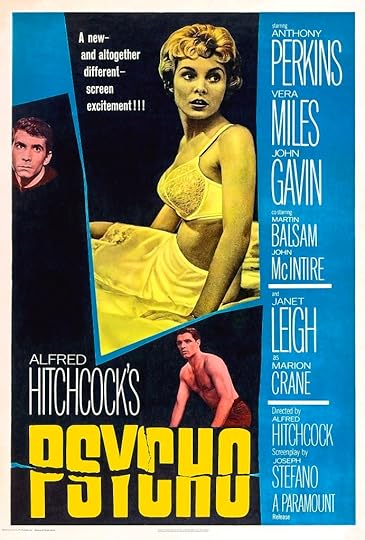 Bloch’s brilliant Psycho made into the famous Hitchcock film.
Bloch’s brilliant Psycho made into the famous Hitchcock film.This story, though written later than many of the other stories, seems as though he was trying to tack on his mythos into something a bit more gothic in nature. In essence this is a sequel to a Robert Bloch story (“The Shambler from the Stars” of which I have not read, so feel free to take this critique with a grain of salt. I’m making assumptions based upon what I know of Bloch’s work. Though he does bring in insanity nicely in much of his work. Think “Psycho.”) and we have some amazing imagery and some quintessential Lovecraftian academic themes (I’ll explain later), but when we boil it down to the ending, I initially felt it was phoned in…that is until I thought about his wording. What is a Haunter, really?
Right off the bat we are told the ending, “Cautious investigators will hesitate to challenge the common belief that Robert Blake (read Bloch) was killed by lighting.” and we know immediately that Blake will die from whatever he gets himself into. This also leads into the broader gaming aspect which has made Lovecraft so popular. Being an “Investigator” and endeavoring to reveal what kind of strange death or rare occurrence happened is the corner-stone of the gaming experience, and this story is a good example of how that framework came about. There aren’t really investigator characters in Lovecraft, but there are the curious interlopers and in stories like this the characters go down a rabbit hole which is exactly where the ideas of the game come into play. Things like finding artifacts and texts which lend to further understanding of the Lovecraft universe are probably what sparked the idea for the game in the first place. Which leads me to a wonderful scene in the tale.
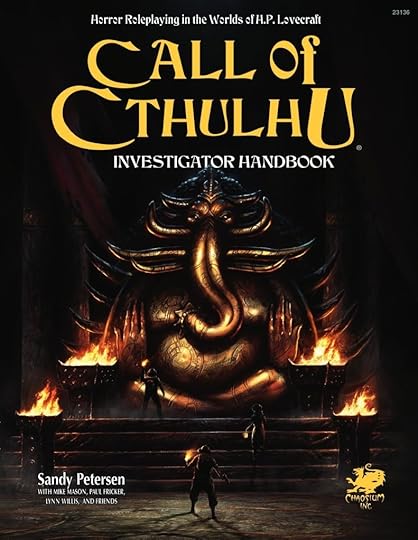 The brilliant RPG by Chaosium based on Lovecraft’s works
The brilliant RPG by Chaosium based on Lovecraft’s works“When he did look away, it was to notice a somewhat singular mound of dust in the far corner near the ladder to the steeple. Just why it took his attention he could not tell, but something in it’s contours carried a message to his unconscious mind. ploughing toward it, and brushing aside the hanging cobwebs as he went, he began to discern something grim about it. Hand and handkerchief soon revealed the truth, and Blake gasped with a baffling mixture of emotions. It was a human skeleton, and it must have been there a very long time.“
This tense exposition is a perfect example of the gothic nature of the story, but it’s slow burn displays it’s brilliance. We can feel the environment, the cold stone, the cobwebs, the air thick with dust, and everything there holds meaning. The skeleton uncovered is actually an old reporter from the defunct paper “Providence Telegram,” and a notebook Blake finds on the skeleton holds the history of what transpired to that poor soul.
There is also the oddity of the bones themselves. Yes they’ve been there for years, but there seems to be something strangely nefarious in the dark “The skull was in a very particular state – stained yellow, and with charred aperture in the top as if some powerful acid had eaten through solid bone.” There are even bones with “seemed oddly dissolved at the ends.” What could have possibly eaten through his head? There is even mention of a blackening, like lightning. Strange happenings, and even through the end we don’t get a complete resolution…that is until we dig into the text a bit more.
So what was it that caused this reporters death? Was it shock? Herat attack? Was there some strange electrical charge which did this? Acid? Perhaps we might look to his journal:
“Fr. O’Malley tells of devil-worship with box found in great Egyptian ruins – says they call up something that can’t exist in light. Flees a little light, and banished by strong light. Then has to be summoned again. Probably got this from deathbed confession of Francis X. Feeney, who had join Starry Wisdom in ’49. These people say the Shining Trapezohedron shews them heaven & other worlds, & that the Haunter in the Dark tells them secrets in some way.”
So was this a cultist haven instead of a church? What is the Shining Trapezohedron? What kind of wisdom did the Haunter show them, and who is the Haunter? The layout of the church itself is even curious, “The designs were largely conventional, and his knowledge of obscure symbolism told him much concerning some of the ancient patterns.” and even more strange, “Blake noticed that the cobwebbed cross above the altar was not of the ordinary kind, but resembled the primordial ankh or crux ansata of shadowy Egypt.“
There are even strange texts there in the old chapel area, “a Latin version of the abhorred Necronomicon, the sinister Liber Ivonis, the infamous Cultes des Goules of Comte d’Erlette, the Unaussprechlichen Kulten of von Juntz, and old Ludvig Prinn’s hellish De Vermis Mysteriis. But there were others he had known merely by reputation or not at all – the Pnakotic Manuscripts, the Book of Dzyan, and a crumbling volume in wholly unidentifiable characters yet with certain symbols and diagrams shudderingly recognizable to the occult student.“
Blake continues further up past “Yellowish stains and charred patches (were) found on the ladder to the windowless spire,” where he finds a strange shining stone (The Trapezohedron) and glimpses the vast secrets of the universe within it. He sees beyond Yuggoth (Pluto as we found from “Whisperer in Darkness”), he sees the history of the strange Mi-Go first coming to Antarctica, lost continents lost to the sea (Atlantis? R’lyeh?) all the way through to Egypt…where Nyarlathotep corrupted. But the visions also seemed to call something forth. Something large and winged and darker than the night. Something which lives in darkness and something that, now that he has gazed into the stone, knows about Blake and can see into him as well. Sees him and speaks to him, even after the box with the strange shining stone is closed. The Haunter in the Dark.
 Cenobite Puzzle Box from Hellraiser
Cenobite Puzzle Box from HellraiserHere is Lovecraft bringing in his classic theme of shape to something new and devious. The Shining Trapezohedron immediately makes me think of the puzzle box from Hellraiser, could this be that Lovecraft has created yet ANOTHER trope for the horror genre? Well, whether he did or not, he does bring back his infamous odd angles. If we remember back with “Dreams in the Witch house” (probably the best designation of this theme), Lovecraft uses strange angles and shapes to give off the feeling that something is off. When buildings are convex instead of being concave as in “The Music of Erich Zann” and it gives the reader a feeling that something unnatural is happening, but in “Dream in the Witch House” the odd angles actually create magic. They create a space where our reality has folded into different angles and the spaces between the dream world, the universe, and time, are thin. Something Stephen King would have called a “thinny” in his Dark Tower series. This thin space allows magic to flow into our world, but it also gives us glimpses into worlds beyond our ken, much like this Trapezohedron…or even the puzzle box.
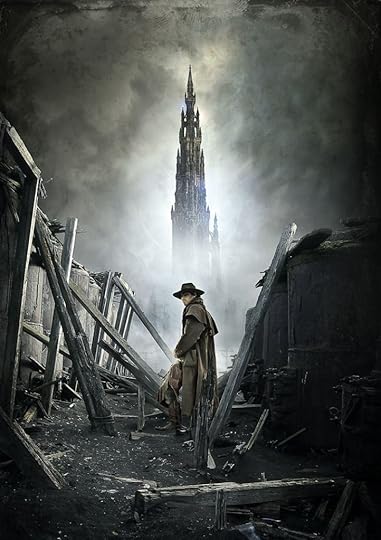 The Dark Tower series by Stephen King
The Dark Tower series by Stephen KingSo the “Haunter” who seems to live in the space of the box, now has a view to Blake, but then something terrible (at least for Blake) happens. There is a terrible storm and the power goes out. Because we know the Haunter lives in the dark and fears the light, there is a mounting fear through the remainder of the story, until finally we get to the climax.
Through the dark they find Blake, frozen before his window. There were the familiar burn marks on the top of his head, however the glass of the window was unaffected, also “...a burst of the singular foetor was likewise noticed.” in his room.
“The rigid body sat bolt upright at the desk by the window, and when the intruders saw the glassy, bulging eyes, and the marks of stark, convulsive fright on the twisted features, they turned away in sickened dismay.“
They couldn’t wrap their minds around what could have possibly happened so they said it had to be lighting…lightning that scorched the top of his head, much the same as the journalist in the church spire. There is also that Fetid Odor (yep I meat to capitalize it. There are so many mentions of the “odour” in Lovecraft that I feel as though it’s the outsider calling card. It just deserves something more.) which pervades the room and emanates from the body.
To me there is something far more disgusting going on here.
If we look up the definition of “Haunter” in Webster’s one of the meanings is “To remain persistently; to loiter; stay or linger.” and the story is built upon the premise that Blake saw something of the Haunter in the Trapezohedron and it has come back for him, but that doesn’t really fit with the title.
I think what’s really going on here is the Haunter is a being, or beings, who use the Trapezohedron to traverse time and space, much like the witch did in her strangely angled house, and when Blake gazed upon it the knowledge it gave him was of the universe. But to give that knowledge it implanted, or impregnated, his brain with a thought child. A thought child that grew in the darkness, because what it was used to was the void of space. No, the Haunter didn’t come from outside, the Haunter lingered in Blake’s brain until it grew large enough, by feeding on his psyche. It waited until it was dark enough to extricate itself from his mind and not be damaged by the light. It used the synapses of his brain to create an exit and literally fried an exit hole through his skull. That’s why his head looked like it was hit with lightning. That’s why there’s the strange fetid (read fungoid) odor coming from his head.
We found out in “The Whisperer in Darkness” that the strange smell which is re-occurring in Lovecraft is actually that of a rotten fungous, which is the smell of Yuggoth. And what is a fungous? It’s a parasite. It grows from others nutrients. It’s a passenger. It’s a Haunter.
Join me next week as we dive into another of Lovecraft’s comedic short tales, IBID!
February 11, 2021
Blind Read Through: H.P. Lovecraft; The Whisperer in Darkness, Conclusion
“With the memory of the roadside claw-print fresh in my mind, Akeley’s whispered paragraphs had affected me queerly; and the hints of familiarity with this unknown world of fungous life – forbidden Yuggoth – made my flesh creep more than I cared to own. I was tremendously sorry about Akeley’s illness, but had to confess that his hoarse whisper had a hateful as well as pitiful quality. If only he wouldn’t gloat so about Yuggoth and it’s black secrets!”
Welcome back for another Blind Read! This week we conclude our dive into the strangely fungoid world of the Mi-Go and talk about the last half of The Whisperer in Darkness.
So the first half of the story was our narrator gathering information about what happened to Akeley and the strange other-worldly beings who turned out to be harbingers for the remainder of the tale. In this second half we have the narrator’s (Wilmarth) trip to Vermont and the subsequent confrontation with Akeley.
As we begin this second half Lovecraft infuses a strange feeling of a descent by describing the trip from the city to the “more primitive New England.” We get the visuals of the Industrial revolution with “foreigners and factory smoke, billboards and concrete roads” as we descend and “As I did so it seemed to me that I was likewise turning the calendar back a century.“
This is a lengthy (in page number) traverse through the country on our way to find Akeley’s farm and it actually feels as though this is an intended technique. Lovecraft is giving us time, as readers, to transcend the modernity of which the story had been taking place, and supplanting that with this metaphorical descent into the old and unknown. We even get introduced to a new and unnerving character, one Mr. Noyes, a particularly put together but aloof young man with a faint Bostonian accent whom serves as Wilmarth’s driver. If this seems strange to you you’re not alone, our narrator felt it as well, “Remembering what a hermit Akeley had been, I was a trifle surprised at the ready availability of such a friend” (to come down and pick the narrator up and bring him to the farm). There is the mention of Akeley having “a sudden attack of some asthmatic trouble.” which is curious because throughout this tale, even in the quote which opens this essay, we have mention that these creatures are a fungi. Fungus are a spectacular way to develop asthma or allergic reactions and it seems as though Akeley is having those more and more frequently of late. In fact even a few pages later when our narrator finally gets to the farm he tells us “They were the hellish tracks of the living fungi from Yuggoth.“
Noyes tells our narrator that Akeley would love to see him, but he is in a difficult state. His “Asthma” is so bad that he’s incredibly sick and cannot get up. It’s so bad in fact that he must spend his time recovering in the dark heavily blanketed. Yeah…that’s some gnarly Asthma.
The narrator gets to the room and immediately wants to leave…”Perhaps it was a certain odd odour which I thought I noticed – though I well know how common musty odours are in even the best of old farmhouses.“
I highlight this because throughout this series I have notated many times Lovecraft has mentioned the strange odors and they always revolve around these outer gods or their subservients. I’ve always assumed that there was some kind of sulphuric smell, indicating a connection with the Devil or the underground (in fact if memory serves, there was a single mention of this specific olfactory note), but I wonder if all along it was actually the musty, slightly vegetative rottenness of fungi which these characters have been notating as the funk. If these Yoggothians are parallel or even ubiquitous with great gods such as Azathoth (which this tale seems to indicate), then the strange odors which these characters smell in almost every Lovecraft work is fungus.
This makes Lovecraft’s works powerful on so many levels! Even now, modern science is looking for extraterrestrial life, but so far all that we can find which could exist in the chemicals of our galaxy is but single cell organisms and fungus. Lovecraft is contending that these creatures come from Pluto (read Yuggoth), and though we know that planet is covered in ice, it does not preclude the possibility of fungus. The fact that these ancient creatures are fungous made sentient and have been around since the dawn of time is just so intriguing, when you contrast that with the evolution of mankind beside them.
There is so much of this we could dig into, but I’m going to save that for a later post…anyway, back to the story…
The narrator sits down with Akeley in the dark and they begin to discuss what’s been going on. Akeley jumps right into the hard science:
“Do you know that Einstein is wrong, and that certain objects and forces can move with a velocity greater than that of light? With proper aid I expect to go backward and forward in time, and actually see and feel the earth of remote past and future epochs. You cant imagine the degree to which those beings have carried science. There is nothing they cant do with the mind and body of living organisms. I expect to visit other planets, and even other stars and galaxies. The first trip will be to Yuggoth, the nearest world fully peopled by beings…
Yet I am going there.”
We spend nearly the entire rest of the story going over the logistics of what these outer beings do to gather humans to travel faster than light or time. The problem is our corporeal selves…at least that’s what Akeley was told. They have a specific method of extracting the brain and setting it in a tube. This metal tube is what would make the transition through space and time and thus give the consciousness of an individual being greater knowledge and understanding…all they have to sacrifice is their own body.
Akeley, cloaked in darkness, makes a motion to the tubes in the room and one of them begins to speak to our narrator. The disembodied consciousness describes to Wilmarth of the great expanse which he has seen (the brain in the tube…not Wilmarth) and will soon see again. The knowledge of the larger world and that these fungoid creatures mean us no harm, but that they indeed want to increase our knowledge of the wider world.
They spend the night trying to make our narrator believe that their intentions are honest. That they are not trying to hurt him and all of this begins to make a little sense. The letters from Akeley going from concern, to fear, to understanding, and when you’re reading it (as you can tell from the previous essay I posted last week) you get the distinct feeling that there is something off about the whole scenario. That these creatures are only putting up a front. That Akeley is being tricked and he’s not really going to be able to go off and do these things.
But nothing actually happens. The narrator just goes to sleep and leaves Akeley to converse with the strange brains in the tubes and with Noyes… and when he wakes Akeley is gone. So in the end this doesn’t actually turn out to be a horror story because Akeley gets to go out to the stars and experience the strange like very few humans have ever before.
Record scratch…
Let’s back this up shall we?
When the narrator first gets to the farmhouse he notices a strange vibration in the air that immediately makes him feel off, then there was Akeley himself:
“For a moment the closed blinds allowed me to see very little, but then a kind of apologetic hacking or whispering sound drew my attention to a great easy chair in the farther, darker corer of the room. Within it’s shadowy depths I saw the white blur of a man’s face and hands.“
“There was a touch of the pitiful in the limp, lifeless way his leans hands rested in his lap. He had on a loose dressing-gown, and was swathed around the head and high around the neck with a vivid yellow scarf or hood.“
“It was a hard whisper to catch at first, since the grey mustache concealed the moment of his lips, and something in its timbre disturbed me greatly;”
And our narrator was given a coffee: “My first spoonful revealed a faintly unpleasant acrid taste, so that I did not take more.”
The characters also mention the Necronomicon again and again, and as we know from Lovecraft’s previous works this is not a tome of the Other Gods, but instead it’s a tome of necromantic magic that uses (sparsely) the powers of the cosmos.
So then what the devil is going on here? As it turns out the Akeley we meet is not who he says he is. That final letter we get from Akeley is actually not Akeley either, but an impostor and the really terrified letter the narrator received was the last communication Akeley sent before he was taken by these creatures. The form in the shadows…the titular Whisperer…is a creature from beyond, whom is covered up and disguised so that Wilmarth, our narrator, doesn’t notice that it’s not him. The horror doesn’t really come until the last line of the story, when the confusion of the events begins to unfold:
“For the things in the chair, perfect to the last, subtle detail of the microscopic resemblance – or identity – were the face and hands of Henry Wentworth Akeley.“
When we look back at the last phonograph Wilmarth hears, we know that Akeley was taken against his will:
“...brought it on myself…sent back the letters and the record…end on it…taken in…seeing and hearing…damn you…impersonal force, after all…fresh, shiny cylinder…great God…“
Between this recording and the hidden Akeley we know that whomever is at play…possibly the nefarious Nyarlathotep (whose name is uttered in one of the recordings), does not have philanthropy at heart. They are harvesting something. To me, all of these things happening at a farm indicates a brutal and corrupted sense of humor…one that is right at home in Lovecraft.
Join me next week as we seek out the Haunter in the Dark!
February 4, 2021
Blind Read Through: H.P. Lovecraft; The Whisperer in Darkness, Part 1
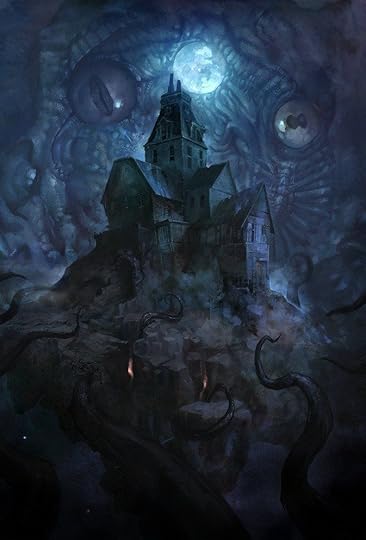
“The unknown things, Akeley wrote in a script grown pitifully tremulous, had begun to close in on him with a wholly new degree of determination. The nocturnal barking of the dogs whenever the moon was dim or absent was hideous now, and there had been attempts to molest him on the lonely roads he had to traverse by day.“
Welcome back to another Blind Read! This week we’re diving into the new strange world of the Vermont Backwoods as our narrator strives to solve the mystery of one Henry Akeley. We get glimpses of Cosmic horror, the dream lands, and a brand new call back to a horror trope (the one appearing here, I’m pretty sure Lovecraft probably created!) as we descend in this world and strain to hear the Whisperer in Darkness.
Lovecraft begins this story with an enigma; “Bear in mind closely that I did not see any actual visual horror at the end.”
It’s a strange way to begin a short story because it leads the reader to infer that the narrator didn’t actually see anything throughout the story…so how is there a story to even tell? This can be a daunting assignment as we look at the sheer length of the tale but as we peel back Lovecraft’s language, we begin to see that he didn’t “see” anything, but that doesn’t preclude audible horror and given the title of this story, I think the denouement is going to be quite the romp. Besides which fact that this is what Lovecraft does best. He beats around the bush, deftly hiding from his audience what’s really going on, because the very nature of his horror would be ruined by the descriptors. In this story, we do in fact get a description, but it’s of dead creatures who may or not be real and the corpses disappear before any inspection can take place…that only makes it that much more terrifying when the encounters begin.
We start the story with the classical skeptical narrator (who very well could be unreliable. We’ll get t that later), who has heard a number of strange happenings in the woods surrounding his friend Akeley’s house. The folk tales speak of, “…pinkish things about five feet long; with crustaceous bodies bearing vast pairs of dorsal fins or membranous wings and several sets of articulated limbs, and with a sort of convoluted ellipsoid, covered with multitudes of very short antennae, where a head would normally be.”
So here we get our first glimpse of some freaky Lovecraftian stuff, but our narrator defers; “It was my conclusion that such witnesses – in every case naïve and simple backwoods folk – had glimpsed the battered and bloated bodies of human beings or farm animals in the whirling currents; and had allowed the half-remembered folklore to invest these pitiful objects with fantastic attributes.”
Although our disparaging narrator disavows the local folk on prejudice alone, he does dive into the mythology of the area. We hear how these backwoods folk have adapted to them, “the common name applied to them was ‘those ones,’ or ‘the old ones,’…” so we already know there’s some validity to these destitute whom the narrator disparages. They have knowledge of the Cthulhu Mythos. It does makes sense because these are the type of people who distrust outsiders, whom take care of themselves; so if something like this were to become a regular occurrence, then having it happen in this type of locale with these types of people make the most sense because they wont be going outside of their bubble to talk about it.
We also learn that the Native Americans had stories about these strange creatures as well. “They talked with their heads, which changed colour in difference ways to mean different things.”
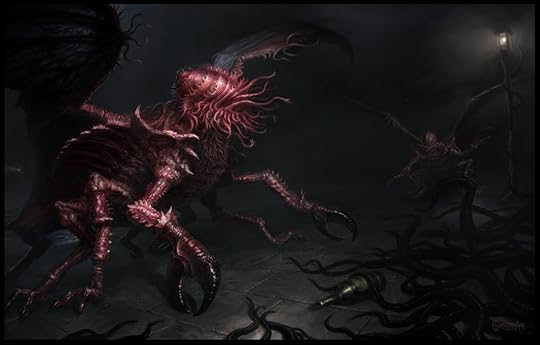 Mi-Go of Yuggoth
Mi-Go of YuggothThen to cap off everything the narrator ties in that he’s heard about a Nepalese Abominable Snow-Men species, whom they call the Mi-Go (Which I believe were also referenced in “At the Mountains of Madness“). This is where the story turns from the normal garden variety horror to an aspect of the Mythos.
The Farmer who disappeared (Akeley) whom our narrator is searching for, has knowledge of forbidden tomes. He knows about the Necronomicon and in one of his letters he even states, “the Yog-Sothoth and Cthulhu cycles – which were hinted at in the Necronomicon.”
These things are so outside of our everyday reality that our narrator continuously dis-believes his erstwhile friend and contends that it must just be natural phenomena. The claw prints outside of his house, the strange whisperings he hears in the darkness, the strange corpses of creatures he cannot explain. He disavows the claims because the corpses soon disappear and Akeley has a neighboring crotchety old farmer by the name of Brown who he holds accountable for all the other occurrences.
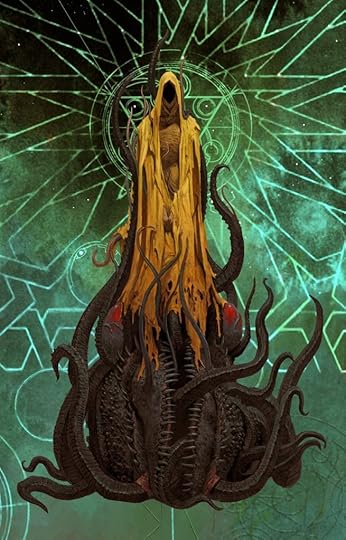 Hastur
HasturBut the more and more our narrator looks into these night occurrences, the more and more he delves into the mythos: “I found myself faced by names and terms that I had heard elsewhere in the most hideous of connections – Yuggoth, Great Cthulhu, Tsathoggua, Yog-Sothoth, R’lyeh, Nyarlathotep, Azathoth, Hastur, Yian, Leng, the Lake of Hali, Bethmoora, the Yellow Sign, L’Mur-Kathulos, Bran, and the Magnum Innominandium – and was drawn back through nameless aeons and inconceivable dimensions to worlds of elder, outer entity at which the crazed author of the Necronomicon had only guessed in the vaguest way.”
The first half of this tale is an expansion of the mythos in general, and we finally get an understanding of where the outer gods call home.
With the knowledge we have of what the universe looks like, this revelation is a little lack luster, but if you think back to what we understood of the universe in 1919 and imagine what it must have been like for people when scientists said they discovered a “new planet beyond Neptune” and then Lovecraft included that new dwarf planet into his mythos? The fear that might have been invoked, especially when the planet was given the name of the god of the underworld…Pluto. Lovecraft put his stamp on it. Pluto is where these strange, alien, creatures came from (though the mythos name for it is Yuggoth). The Mi-Go, who worship Yog-Sothoth and Shub-Niggurath (the goat with a thousand young and the mother of many gods of the mythos), who bow to Hastur, and do the bidding of Nyarlathotep, call Pluto home.
 Newspaper espousing the discovery of Pluto…notice the Prohibition story on the right!
Newspaper espousing the discovery of Pluto…notice the Prohibition story on the right!We also know the grand daddy of the mythos, Azathoth, also wanders blindly around the vacuum of space. One with the limited knowledge of how large the Universe was at the time, can only assume that Azathoth must have been wandering just past Pluto. Thus when Randolph Carter went sailing in his Dream-Quest and came into contact with Azathoth, he was wandering beyond the icy mountainous ranges of Pluto and it’s Mi-Go inhabitants.
This is just another nail in the coffin of belief that the dream-lands and the real world are fluid. The dream lands are more like a parallel universe, where there are gates between our world and the worlds of the Outer Gods. So few humans have experienced it, but many of the creatures of that dream realm have breached the barrier and have come over to our world. Our narrator even feels this as he tells us “My own zeal for the unknown flared up to meet his, and I felt myself touched by the contagion of the morbid barrier-breaking.”
So now we have set the stage. We know that our narrator will not “see” anything throughout this story, so we can only hope to garner inference (are the claw marks part of Shub-Niggurath’s thousand young? Is it a coincidence that Satan is considered goat like, while Shub-Niggurath is the mother of goats?) from the correspondence that Akeley sends our intrepid narrator…which brings us to our next point.
 The Blair Witch Project…the movie that made “found footage” famous.
The Blair Witch Project…the movie that made “found footage” famous.It feels like Lovecraft has created a new horror trope in this story which I’m sure has not existed before this point. The reason I’m sure is because of the availability of technology…and that is the trope of “found footage.”
As we progress through the story Akeley tells our narrator of various things which have transpired around him which we have already mentioned – the whisperings in the dark, the claw marks, the Mi-Go corpses (which incidentally disappear and fade back into the dreamlands) – and he goes through the normal progression of a character in a Lovecraft story…he suspects and is scared, he becomes terrified and pleads for help, he suddenly turns this around and says he was mistaken and he is in no danger, then he disappears. This is a theme which Lovecraft has instituted in many of his stories (take “The Case of Charles Dexter Ward” for example), but the layer he adds into this tale is a recording phonograph and a Dictaphone.
We get passages like this:
(A CULTIVATED MALE VOICE)
…is the Lord of the Woods, even to…and the gifts of the men of Leng…so from the wells of night to the gulfs of space, and from the gulfs of space to the wells of night, ever the praises of Great Cthulhu, of Tsathoggua, and of Him Who is not to be Named. Ever Their praises, and abundance to the Black Goat of the Woods. Ia! Shub-Niggurath! The Goat with a Thousand Young!
(A BUZZING IMITATION OF HUMAN SPEECH)
Ia! Shub-Niggurath! The Black Goat of the Woods with a Thousand Young!
The narrator spends time cultivating what it must have been like to listen to this passage, and though we are jaded now, at the time this was a unique and never before seen tool. Lovecraft was able to give an audible, visceral take on what it must have been like for this man to be sitting in a darkened room, listening to a scratchy Dictaphone espousing these words in barely human tones.
“To this hour I shudder retrospectively when I think of how it struck me, prepared though I was by Akeley’s accounts.”
I leave you with that slight feeling of unease. The feeling that you are being watched by some unseen Whisperer of ancient horrors. Watched by a group of alien creatures who’s motivations are unknown. Watched.
“There seemed to be an awful, immemorial linkage in several definite stages betwixt man and nameless infinity. The blasphemies which appeared on earth, it was hinted, came from the dark planet Yuggoth, at the rim of the solar system; but this was itself merely the populous outpost of a frightful interstellar race whose ultimate source must lie far outside even the Einsteinian space-time continuum or greatest known cosmos.”
Join me next week as we conclude “The Whisperer in Darkness”
January 31, 2021
Someone Else’s Atrocious Story

03/12/19
1:45 AM
Yo Chad,
What up man? How are things out there in Cleveland? They been rough for me man, I don’t mind tellin y’all. I’m so damn grateful that I have someone to talk to. My girl up and left me last week. You believe that shit? I mean damn what a year. My momma dies, my bro in a coma because of some middle-eastern crazy and then up outta the blue, she just ghosts me. I wake up one day and she just gone. Somehow she packed all her crap up and got out the door before I even noticed. How could someone be so cold like that? I give the best years of my life and she just up and disappears! Anyway. How are you and Charnelle? Haven’t seen you talk about her in a while on Facebook. You still into all that fantasy shit? I member back in high school, you hung out with them dweeby kids. Always thought you were cool, man, don’t know why you killed your reputation by hanging with those kids. Anyway. I guess the reason I asked was I’ve been into something a little weird and I figger you’d probably be the best person to ask because of all the nerdy D&D stuff you used to do. Anyway. Hit me back man. Peace.
03/13/19
4:00 PM
Dear Travis,
I have to say, I’m a little surprised to hear from you. I was shocked to see you send me a friend request on Instagram, but then seeing your DM asking for my email? I thought you hated me in high school. I mean, I wasn’t super thrilled about you either, but you really went out of your way to torment some of my really close friends. Was that email supposed to be an apology? I would really hope so.
Yes. I still play D&D. Although it goes far beyond that game. We have all kinds of games we play now. Yes, I still play with those “dweebs”, Mark, Winston, Steve, and Clinton. And yes, if you continue to make fun of them I will block your email and everything you have on social media. Your girl won’t be the only one to ghost you. Please ask what you want and don’t play act like we’re friends.
03/13/19
4:09 PM
Travis,
Sorry if that was harsh. How’s Cincinnati?
03/14/19
2:13 AM
Yo Chad,
Pretty harsh man. I mean that was high school; what like three years ago? People change. Damn. I won’t make fun of any of your stupid dweeby things anymore. Anyway. Cincy’s pretty strange. It’s not much different from High School in Columbus. I liked working at the mechanic’s shop. The owner was dope. Dude never really cared what I did. Then his damn son in law took over. Dude’s blacker than night, and just has that fake smile ya know? Swear he only fired me because he wanted to bring his damn rap friends around. Anyway. I know. I kinda popped up outta nowhere, huh? I was just thinking back on old times, ya know? Thinking ‘bout how I never really reached out to you when I probably should’ve. You’re a really smart dude. Which is a damn stupid thing to be, by the way. Anyway. You’re smart, and you read a lot, and you play those games. I’m pretty sure I’ve heard you talk about fighting things like ghosts and vampires and stuff. And Zombies. You guys fought zombies. Anyway. You know about that stuff?
03/15/19
12:43 PM
Travis,
Gee, I wonder why your girl left you. Not like you spout out that hate stuff. Yes, we‘ve had campaigns against undead. I’m surprised you know about “dweeby” stuff like that. And I have to say, the fact that you think being smart is not good, is frankly…well I guess it makes sense. So what brought this on? Why are you reaching out? What do you want?
03/15/19
11:36 PM
Chad
Dude. That was harsh. I’m just talkin’ here. Why you so aggro? Anyway. I wanted to run something by you. I was thinking about how when we were freshman, you let me copy off your test in math class. We was a damn good team dude. We crushed that year bro, we worked so good as a team! I got something to make us a team again! Like, that really good team we were! Hit me up.
03/16/19
8:15 AM
Travis,
You told me you would beat me up if I didn’t give you the test answers. We weren’t a team. You were a bully and I was the bullied. Sorry for being harsh, but come on man, you have to realize this. And I don’t need to hit you up, man, we’ve been emailing for days now. What. Do. You. Want?
03/17/19
1:21 AM
Chad,
Ah it’s all good man. Like I said we were in high school. People change. Anyway. I got this…story. It’s a weird one dude. Serious crazy, but it sounded like the crazy in one of your games you nerds play, so I figger I’d ask you to listen to it and give me some pointers. Nothin big. Lemme know.
03/17/19
7:47 AM
Travis
I think I immediately regret this. But. I’ll listen to your story. Before I do, though, I need to set some ground rules, man. No more disparaging remarks about my friends and me. No more racist crap. No more foul language. If you think you can follow this then … go ahead. I know this is against my better nature, but I have to say that I’m kind of curious to see what you’ve come up with.
03/19/19
3:26 AM
Chadman!
You made the right call, bro. I mean, I wasn’t bein that bad. But I feel you on the swear words. I know I’m…crappy at that. See what I did there! Anyway. Here’s the story.
I’m a serial killer. I wasn’t always that way, but then disease hit the land and I don’t have a choice. I kill zombies. I hunt those fools down and kill they ass. The disease hit America hard. The politicians caused it. They lied they ass off so well, that the disease was able to take everything over.
It started slow. Just a dude seeing something strange in a dark alley, or a zombie poppin’ up in the park and people go out and kill it. Sure everyone knew ‘bout the disease, but the point was that you kept your distance from it. If it came near you? You smashed that zombie fool head in. Everyone knows, you get bitten by a zombie, you become one. Swear to Christ, some of them crazy people actually wanted that zombie lovin’. Goin’ out, hanging with their zombie bitch. But you know damn well what happens when someone gets bitten by the zombie disease. They become a zombie themselves.
I ‘member the first time I saw a zombie. I swear they was nothing scarier than that first night. The night of my first kill.
I was changing some transmission fluid on a cherry Chevy Charger. My head was stuck up under the damn chassis. I heard the thing shuffle in. You see that’s what they do. They don’t walk, no sir, they shuffle. I heard ‘em shuffle in, but I couldn’t believe that one had the balls to come into my shop. Then I felt its hand on my foot. It was pullin’ me out from under the car. I freaked the fuck out! It was so ugly, so rotten, so smelly. Just ugly lookin’ you know? I freaked. I was so scared I’d get some of its slobber on me, then it would only be a matter of time before I fell in with their crowd. I grabbed a tire iron. I turned and gave everything I had into that damn iron. The first strike knocked the beast over. I don’t think that ugly light was out of its unholy eyes till the third or fourth blow. I hid the body. I mean I had to. I couldn’t call the attention of the other zombies.
03/19/19
7:50 AM
Travis,
Wow! You leave it like that? You don’t follow that up with anything? Dang man. It’s a pretty intense story. I mean you have some huge flaws in your writing style, but creativity wise…you’ve taken a really out of date trope and…copied it. BUT, you have me wondering what comes next. So what comes next?
03/21/19
3:26 AM
Chad,
I tried to go on like normal, you feel me? I mean I knew those things were out there. I knew they were invadin’ the neighborhood. That’s actually what scared me the most. Those…things…coming into my life and changing things to the point where nothing else could be the same. Dicks, making me change to have to deal with them.
At first it wasn’t a big deal. They be around, but you just kinda ignore them, ya know? Then people I knew started to turn. I ‘member being at a bar and talking to this bro I’d shared beers with. He heard me talking ‘bout them creatures, and I could see how he looked at me. Like I fucking stank or something. I mean damn really? They were zombies! What’s wrong with these fools? Later, I saw that dude talking to the zombies. He walked up to ‘em and they talked for a while, but after that day, I never saw that dude again. Stupid people. You can’t hang with zombies and not be infected. Anyway.
Two weeks later I was leaving that bar. I just wanted to have a drink or three and get outta there before the zombies started in. They tended to come around after dark. No surprise there. Anyway. I left the bar and there was a zombie out there. I could tell by the shuffle. It was just dark. The sky was gray, the sun had just gone down and the street lights were lit. They was a zombie in the alley behind the bar.
Usually you can walk right by ‘em. You know, just put your head down and hurry by. They usually let you go. Not this one though. It held out its arm to stop me. I panicked. I knew it was gunna try and turn me. Make me one of … them. I jumped back and grabbed a bottle off the ground. My quick movements seemed to surprise it, but nothing surprised it more that the bottle over its undead head. Then I slammed that bottle home. Right in the neck. I worked that thing. I’m not proud of it. Oh what the fuck, I’m damn proud. It scared me. It was nasty. But eventually that damn zombie finally died. I hid the body in the dumpster back there, then started a fire.
03/21/19
8:04 AM
Travis,
Well, like I said before you need to work on your writing voice. But, for sure, bringing in real events like that will make the story come to life a little more. That dumpster fire was brutal man. I think like three people died at that club. When the fire hit the club people panicked and I think one of the people died because they got trampled. That might be something that you want to talk about a little in the story. The repercussions of the story. The ancillary deaths and injuries. The mental response from people.
Yikes! I almost said anyway. God I can hear you voice when I read your story. Keep it going. The reality is a bit disturbing, but I guess it’s a horror story, so it should be disturbing.
03/25/19
2:26 AM
Chad,
Ancillary? I looked that shit up and I still don’t get it. Anyway. Cool. Glad it makes sense, ‘cause you know, you’re a nerd and you know these things.
I went home that night and thought ‘bout what happened. I thought I was gunna feel weird about it. You know, killing those zombies? I thought maybe I didn’t feel bad after killin’ the zombie in the garage ‘cause of shock, ya know? But the more I thought about it, I was like, well yeah. Its zombies. I mean come on. Some people might not want to get their hands dirty, but deep down, everyone wants to kill those zombies.
So I sat at home and figured out a plan. I’d be really careful. I’d pick one off at a time. Then I’d throw them in the incinerator at the paper factory. You know, thin out the herd and make it safer for everyone else. Bring back some safety to the neighborhood.
So I started. I’d sneak around at night and pick off one or two. I’d bash ‘em in the head and take ‘em down, then cut off the head of those terrible stinking creatures. I thought I was doing a great thing. I thought I was doing the right thing. But they just kept coming. Once I really got started I noticed that there seemed to be more than ever. They were everywhere. They were taking over the neighborhood. Damn man, they had already taken over the neighborhood.
I gotta admit. I got kinda scared. I stayed in my house more and more. I’d only go out if I had to go to work or to get food. But everywhere I went they was there. I made sure that I kept my distance from them. I made sure that I never came into contact with those creatures. But other people didn’t seem to care. They’d just join in with that zombie crowd. I knew it was because they’d been infected themselves. I knew they hadn’t turned yet, but damn you could see they felt the effects. I mean why’d they even get close enough to touch a zombie if they didn’t? I had to get more serious. I had to stop fools from getting’ too close to those shuffling things. I knew that meant I had to take down some actual people. Ya know. Like preventative. So I did.
03/25/19
8:26 AM
Travis,
Damn man, this is really creepy. Kinda hitting close to home. You might want to be a little careful with this since there have been some disappearances lately. You don’t want the police or anyone thinking that you might have something to do with these disappearances. Tell me you don’t have anything to do with those man, and I’ll believe you. It would make me feel a hell of a lot better if I knew that you weren’t out there kidnapping people. If I knew you weren’t…killing people. I mean I never really liked you that much, but that’s next level.
I know you’re kind of a dick, but I don’t think you could actually kill anyone. Again, just tell me its true man and I’ll believe it. You never seemed to be someone that would do something like this. I even asked around to some of your friends. It made me make Facebook friends with them, which I’m not thrilled about, but they seemed cordial enough. They did say that you had become a little more reclusive, but also that you were just your normal self when you were around them. You’re freaking me out a bit man. Tell me what’s going on.
03/30/19
3:47 AM
Chad,
Yeah no worries bro. I mean the story is about a serial killer, but I’m not a killer. I’m a mechanic, bro, not a killer. Anyway.
After taking a few of them down, I noticed the issue got a little better. People stayed away from the places that I focused on. Less fools seemed to be turning into zombies. I mean, everything seemed to be going fire. I only saw zombies here and there. So I go out and I got a couple of guns. I got a machete. I even got a damn bow. I wanna make sure I could protect myself in case they started coming back round. Bro, it made me feel better. I even named my Glock Betsy. She slept beside me. Actually she still sleeps beside me. Right there on the other pillow.
Then one day a zombie came knocking on the door. Just damn brazen. Came right up and knocked. I couldn’t believe it. I grabbed my machete, ‘cause I always have it in the umbrella stand next to the door. I opened the door a crack and that zombie stood there looking at me. I grabbed it by the shirt it was wearing and threw it onto onto my hardwood floor. I kicked the door shut and brought the machete down on the creature. It cut like butter. That fool zombie moaned a bit, as only a zombie can, but then it died.
I buried it in my back yard. I couldn’t believe that stupid ass thing came right up to my door! I realized I didn’t protect myself enough against these things. So I boarded up my house. I nailed boards on the windows. I put multiple deadbolts on the doors. I boarded up my back door and the side door. I kept wood next to the front door, so in an emergency I could board that up. I loaded up the basement with C4. I mean I wasn’t gunna let those things win, ya know? There was no way I was gunna let them change me. Anyway.
Nothing happened for a while. The zombies seemed to get the idea. Then I made the mistake of turning on the TV. The zombies were everywhere, bro. Fucking everywhere. Then there was a news story about zombies gathering at the mall. I thought…damn. This is my chance. I can get rid of them all at once! It’ll be fire! People’d talk about it for ages. I had to take down that mall while they were doing their thing. Obviously any real people there would be…what do you call it? Forfeit? You mess with those creatures, you become those creatures.
03/30/19
12:05 PM
Travis,
I went by your house and it’s boarded up. I looked up the event at the Mall this weekend. It’s an NAACP rally. I’ve called the cops. I’m sorry if you were just screwing around. But this is too serious.
Local News Tonight
In other news, on this Friday March 30th, a homebrew terrorist attack was thwarted. The police arrested Travis Nelson of Cincinnatti, Ohio on suspicion of terrorist attacks and allegedly, multiple counts of murder. Apparently a source which is being help anonymously by the police turned in several emails detailing the story, and upon inspection, all the details were corroborated. Nelson apparently was planning a bombing at the NAACP rally at Century Mall…
January 28, 2021
Blind Read Through; H.P. Lovecraft: Through the gates of the Silver Key

“What happened then is scarcely to be described in words. It is full of those paradoxes, contradictions, and anomolies which have no place in waking life, but which fill our more fantastic dreams, and are taken as matters of course till we return to our narrow, rigid, objective world of limited causation and tri-dimensional logic.”
Welcome back to another mind bending Blind Read! We’ve learned about Randolph Carter in the past, including the indominable Silver Key, but this time we traverse through the doorway this magical talisman produces. Lets dive into a treatise on traversing space, time, dimension, and existence as we traverse through the gates of the Silver Key.
The opening few chapters is basically a rehash of the stories “The Dream-Quest of Unknown Kadath” “The Silver Key” and “The Statement of Randolph Carter.” The story is unique in it’s narration because most of Lovecraft is told from the perspective of a single narrator, but this story begins omniscient and doesn’t more into narration until Swami Chandraputra directly relates the events surrounding Randolph Carter.
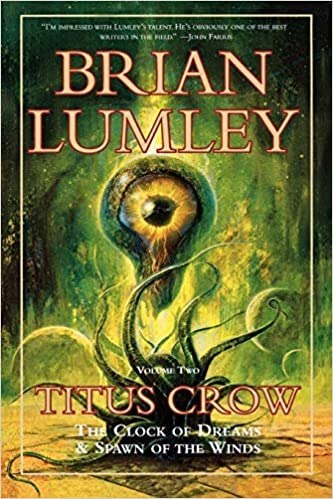
“In a vast room hung with strangely figured arras and carpeted with Bokhara rugs of impressive age and workmanship four men were sitting around a document-strown table.” These four men were Etienne-Laurent de Marigny (Later to be a mainstay in Brian Lumley’s Titus Crow Series), the aforementioned Swami, Ward Phillips, and Ernest B. Apinwall, whom is an executor of Carter’s estate and is trying to sell it all off.
Apinwall tells the other three his goal is selling off the Carter estate, because Carter himself has been gone nearly four years and it’s time to move on. The Swami objects and tells the group he has proof that Carter is alive and needs to make sure that Aspinwall doesn’t sell anything. Once we have the abridgement of Carter’s history we jump right into new territory with the quote which opens this essay.
The actual story is too complicated and intricate to tell in short form here, heck, Lovecraft could barely get it out in long form of the story itself, but the basics are that just beyond where Carter had already gone using the Silver Key, there are more gates, and these gates had only been transcended by a few mortals…ever. Carter traversed these gates and gained an understanding far deeper than any human could ever comprehend.
The story covers what we consider to be Lovecraft’s Dreamlands, so we’re not dealing with a horror story as it is, but something that goes so much farther than that. Serendipity comes to mind because I’ve recently been following Marvel and all that they have been working through, with perceptions of thought and reality and multiverse, which makes reading this story at this time seem so very apt. We’ll dig into what I’m talking about in a moment here, but first I would like to discuss the perception of gods and Gods in Lovecraft.
To open it up, I’d like to give you some straight text from this story:
Carter guessed what they were, whence they came, and Whom they served; and guessed, too, the price of their service. But he was still content, for at one mighty venture he was to learn all. Damnation, he reflected, is but a word bandied about by those whose blindness leads them to condemn all who can see, even with a single eye. He wondered at the vast conceit of those who had babbled of the malignant Ancient Ones, as if They could pause from their ever lasting dreams to wreak wrath upon mankind. As well, he thought, might a mammoth pause to visit frantic vengeance on an angleworm. Now the whole assemblage on the vaguely hexagonal pillars was greeting him with a gesture of those oddly carven scepters, and radiating a message which he understood…
There is a whole lot of theology and thought packed into that one little paragraph!
The first portion is the concept of damnation. If you’ve been following along with this blog then you know Lovecraft didn’t adhere to any specific religion; in the sense that the dogma of the church just didn’t make any kind of rational sense to him. This paragraph is the perfect example of that. People who are either willfully ignorant, or just plain blind to reality as Lovecraft saw it, didn’t understand that if there was a God or gods, then they really dont care about you. Rationally it doesn’t make sense for a supreme being to care about lesser beings, thus indicating that these “gods” were mammoths and we were angleworms. Because these beings dont really care about us, then damnation itself must be a construct of religion to keep people in line. Religion, like governance, is about control and comfort. Humans crave structure despite how we act and react sometimes, and to know that there is a heaven and a hell makes people more at ease. If they go to church on Sunday and say their prayers by night, they wont become a wolf when the wolf bane blooms and the autumn moon is bright. Damnation (at least what this story is trying to convey) is a construct of the mind, and for Carter, it isn’t until he breaks the barrier held in check by the Silver Key that he comes to this realization. He moves beyond one universe into multiple and lives countless lives and endless consciousness’ all at once; giving him a greater understanding than that of even the Mad Arab Abdul Alhazred and his ravings in the Necronomicon. Damnation is a state of mind, not a place.
To piggy back on that we have the conception of the gods in Lovecraft’s mythos. It has been played around with in stories such as “The Dream-Quest of Unknown Kadath”, but not elucidated with such clarity as it is right here in this paragraph. With the notable exception of Nyarlathotep, the gods of Lovecraft are omnipotent, they are not malignant. These gods transcended space, time, and universe, occupying all and none at the same time. They have lived for eternities and will live for eternities more. Their consciousness has developed for hundreds of thousands of millennia, and because of this, their scope is so much larger than the few thousand years humans have existed. In fact, the only reason Nyarlathotep has any kind of vengeance is because humans keep trying to invade and go beyond their bubble. He is a god who believes we are a stain on the beautiful tapestry of consciousness and wants to be rid of our parasitic species. When Cthulhu comes out of the sea at the end of “The Call of Cthulhu” he is not trying to destroy the world, but his simple visage shows the magnitude of what we dont know, and that in-and-of itself is enough to drive everyone, with the notable exception of Randolph Carter, insane. Damnation is tied so closely to the malevolence of gods and the insanity caused by them, but that’s just a construct so that mere mortals can understand. This whole story is all about how the life we live is an illusion of our own construct, and there is so much more beyond our ken.
So lets dig into that multiverse, shall we?
“The man of Truth is beyond good and evil…The man of Truth had ridden to All-Is-One. The man of Truth las learnt that Illusion is the only reality, and that substance is an impostor.”
Carter goes through the first Gateway of existence:
“Even the First Gateway had taken something of stability from him, leaving him uncertain about his bodily form and about his relationship to the mistily defined objects around him, but it had not disturbed his sense of unity. He had still been Randoplh Carter , a fixed point in the dimensional seething. now, beyond the Ultimate Gateway, he realized in a moment of consuming fright that he was not one person but many persons.”

I mentioned Marvel earlier, and I’ve just started watching WandaVision, like many of you may have as well. This show seems to be of a similar set up to Carter’s story. We have Wanda living in a dream world of her own construct (or maybe caused by another to keep her under control with those calls of “Who’s doing this to you Wanda?”) The layers are slowly being peeled back to revel a reality that may just be too difficult for her to comprehend, thus fracturing her mind. Or maybe she has already been through the gates of which Carter speaks of, and what we view every Friday night is a perception of her fractured mind? The idea of a multiverse is complicated, and Lovecraft here barely scratches the surface (hopefully, with the help of Rick and Morty writers, we’ll see a bit more cohesion in the Marvel Multi-Verse). Carter has lived many lives and we’ve seen that in previous stories (in “The Silver Key” Carter was both his adult self and his ten year old self), but when he goes beyond the ultimate door we find that there are many worlds which hold his consciousness. There are countless alien beings which have been “Randolph Carter”, just not in human form. These are not parallel universes, but unique and individual universes with single threads of consciousness which hold things together. Deja Vu? Strange memories of places and things you shouldn’t have? Sudden empathy or hate for a creature or thing? These are all because we have lived these experiences either concurrently or in the past…or even in the future.
Think of a cupcake stand. The saucers are the different universes of which there could be infinite, the pole holding them together is your consciouness and on each infinte saucer there is a different being with different experiences, but with your soul as the connector. Lovecraft describes it here as:
They told him that every figure of space is but the result of the intersection by a place of some corresponding figure of one more dimension – as a square is cut from a cube or a circle from a sphere. The cube and sphere, of three dimensions, are thus cut from corresponding forms of four dimensions that men known only through guesses and dreams; and these in turn are cut from forms of five dimensions, and so on up to the dizzy and reachless heights of archetypal infinity.
A slight change of angle could turn the student of today into the child of yesterday; could turn Randolph Carter into that wizard Edmund Carter who fled from Salem to the hills behind Arkham in 1692, or that Pickman Carter who in the year 2169 would use strange means in repelling the Mongol hordes from Australia; could turn a human Carter into one of those earlier entities which had dwelt in primal Hyperborea and worshipped black, plastic Tsathoggua after flying down from Kythanil, the double planet that once revolved around Arcturus; could turn a terrestrial Carter to a remotely ancestral and doubtfully shaped dweller on Kythanil itself, or a still remoter creature of trans-galactic Shonhi; or a four-dimensioned gaseous consciousness in an older space-time continuum, or a vegetable brain of the future on a dark radio-active comet of inconceivable orbit – and so on, in the endless cosmic circle.
 Dr. Who TARDIS
Dr. Who TARDISIn fact Carter did this. He transcended through the Ultimate Gate into Zkauba, the wizard of Yaddith, a strange bird-insect like creature and lived for years in this being, until he found his way to travel in a “thin envelope of electron-activated metal” (early TARDIS?) back to earth.
And then we find ourselves back in the room from the beginning of the story with Swami finishing his story and the group realizing that Swami’s accent was fake. That Swami’s face was a mask. The Swami himself…was not a Swami. To reveal the truth Carter pulls the mask off releveling the physiognomy of the bird-insect Zkauba as he never moved beyond that bodily form. Between everyone in the group only Apinwall, the lawyer, sees and in his madness at seeing beyond the gates of the Silver Key, flees the scene and doesn’t foreclose on Carter’s estate.
It’s a long strange ride and this being a Blind Read (The first time I’ve read it) I’m sure I missed volumes which others could fill in. As I get closer to completing the entire oeuvre of Lovecraft I’m constantly mystified at how intellectual all of the stories are and now fully understand the praise as one of the early incredible horror authors.
What do you think??
Join me next week as we delve into “The Whisperer in Darkness”
Post Script:
I’m going to be diving into the Titus Crow series now that I’ve gotten the Carter books under my belt. They follow Titus Crow and Etienne-Laurent de Marigny from this story (follow me on Goodreads if you want updates). That tale centers around the strange clock which is the center piece of Carter’s house which the four men discussed Carter’s fate.
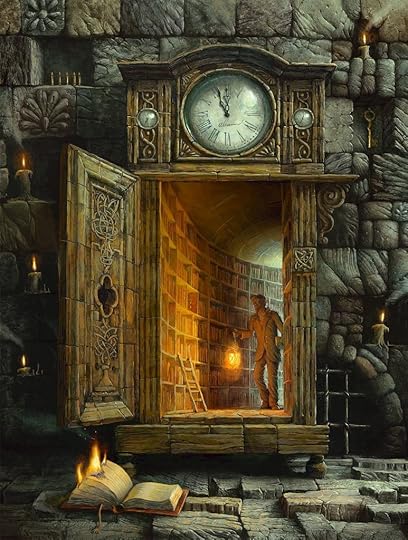
The reason I bring this up here is because it ties together the dream Lands and the waking world so perfectly, where I thought previously that they were two separate, mutually exclusive things. The strange clock has strange hieroglyphics on it instead of numbers:
To him let me say that the language of those hieroglyphics is not Naacal but R’Lyehian, which was brought to earth by the spawn of Cthulhu countless ages ago.
And in sunken R’lyeah sleeping Cthulhu lie…and with strange aeons even death may die.



